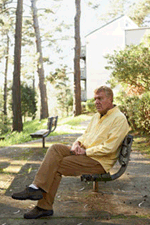
Bill Duane knows most people can’t afford homes like his $1 million bungalow on a hill overlooking San Francisco Bay. That’s why the Marin County attorney volunteered for Habitat for Humanity. Until recently, that is, when the group announced plans to build two affordable duplexes just down the street from him. “Habitat usually goes into a blighted neighborhood and enhances it,” Duane says. “Here, they are coming into an enhanced neighborhood and blighting it.” Housing advocates say Duane exemplifies a vexing irony: People support affordable housing with their labor, money, and votes—just so long as it’s nowhere near them.
Standing beside his garden of coastal succulents, Duane, who looks like a cashmere-clad Rodney Dangerfield, spoke in nervous bursts. He fretted about a note that a retired schoolteacher had sent him inside a Monet greeting card, which began, “You are a disgrace to the human race and should be ashamed of yourself.” His research revealed that the teacher’s home is worth almost as much as his own. “And it’s surrounded by vacant lots,” he exclaimed, “so why don’t you build it there?”
That, too, might be easier said than done: Marin is among the most liberal (and expensive) counties in the nation, but Duane says all of his neighbors back him. Indeed, opposition to affordable housing in the county was so fierce in the 1990s that a Marin chapter of Habitat disbanded, former members say, after finding itself unable to get a single project built in five years. On the opposite coast, in wealthy, liberal Martha’s Vineyard, 10 homeowners sued earlier this year—on environmental grounds—to block construction of an affordable house for a fisherman who’d been living with his wife and children in a tent. In Boulder, Colorado, affordable-housing advocate Joni Lynch says her most strident foes were button-wearing progressives. And in the gentrifying Edgewood neighborhood of Washington, D.C., one resident who fought the construction of the low-income St. Martin’s apartments nearby actually worked for a company that builds low-income apartments.
But few development projects have been more enigmatically unpopular than the Marin project, where three luxury houses will be clumped onto a 17.5-acre hill in a way that preserves most of the land as open space. In accordance with county rules, the developer set aside an acre for low-income housing. There, Habitat will build four units, two melded together to look like one Craftsman-style home, which will be sold at below-market rates to families making $40,000 to $56,000 a year (a teacher in Marin earns on average $47,000).
Duane and I climbed into his Mercedes station wagon and drove to the project site, a hillside of chaparral and grass. He’d promised me it would be obvious that congestion was already bad. A lone Toyota Prius with a “Save Tibet” sticker silently cruised by. “Usually this whole area is packed with cars,” he insisted. And if I researched the matter, he hinted, I might learn that the endangered Tiburon mariposa lily grows here (naturalists doubt it), and that an Indian burial spear discovered nearby might have belonged to the county’s namesake, Chief Marin (a Marin anthropologist says Duane is “reporting things that are not there”). Duane next raised an environmental justice concern: Placing the affordable housing in the shadow of million-dollar homes fosters “a slave kind of mentality.”
He restarted his car and pulled up the slope of Eagle Rock Drive, past gardens of salvia, agave, and bird-of-paradise, pointing out houses already owned by minorities; as if making a point, he waved to an Asian man checking his mail. “It’s a very diverse community here,” he said.
Too diverse for some. Duane’s neighbor, 83-year-old Edward Sotelo, who bought his $1 million property for $3,000 long before Marin real estate boomed, still laments the construction of the nearby Krueger Pines senior citizens’ home. “The characters in those units are not the best kind of people,” he said as he glanced in the direction of its parking lot, home to a late-model bmw and a Porsche. “People say some of them go down to the street and beg.”
The multiplicity of neighborly concerns raised by nimbyists can leave housing advocates guessing what the real issue is. A recent poll by the Citizens Housing and Planning Association in Massachusetts suggests that, across party lines, most opposition to affordable housing boils down to homeowner fear of lowered property values and higher school costs.
At any rate, Duane believes that housing working-class people in high-income areas goes beyond Habitat’s mandate. “There seems to be a change in the idea of what Habitat is,” he says. “It reminds me of what’s happened with the American Civil Liberties Union, which used to be a great institution in the ’30s, ’40s, and ’50s. But now the aclu is saying, ‘Well, we’re going to represent the Mexicans and illegal aliens, rather than Americans.’ They’ve overstepped.” Duane would rather see a new group build visionary, ecofriendly communes in Marin where low-income people can share appliances such as refrigerators. “They should be creating wireless areas of tribal habitats,” he says. Not in his neighborhood, though. He recommends a spot owned by the Catholic Church, several exits down the freeway.
















